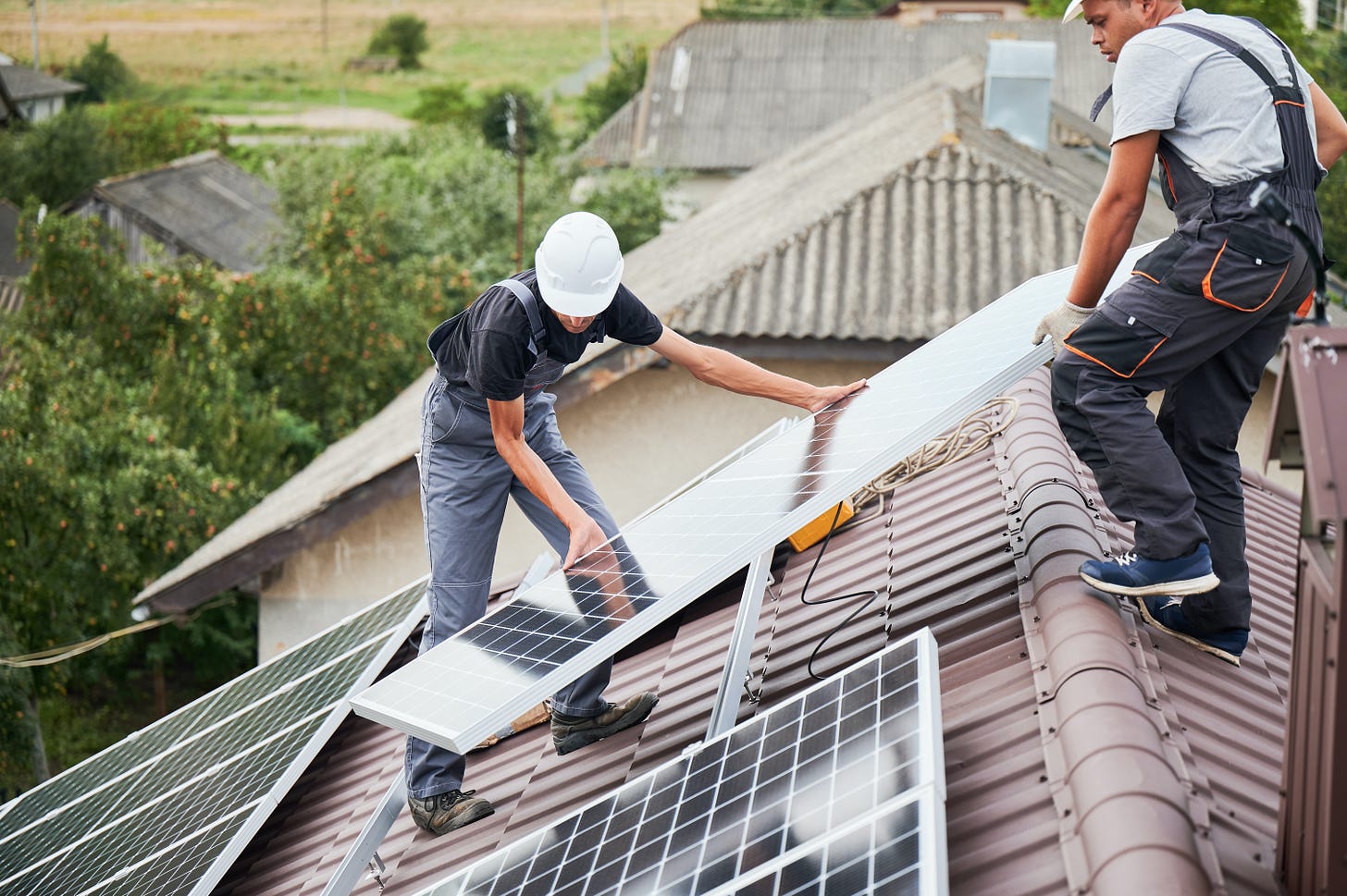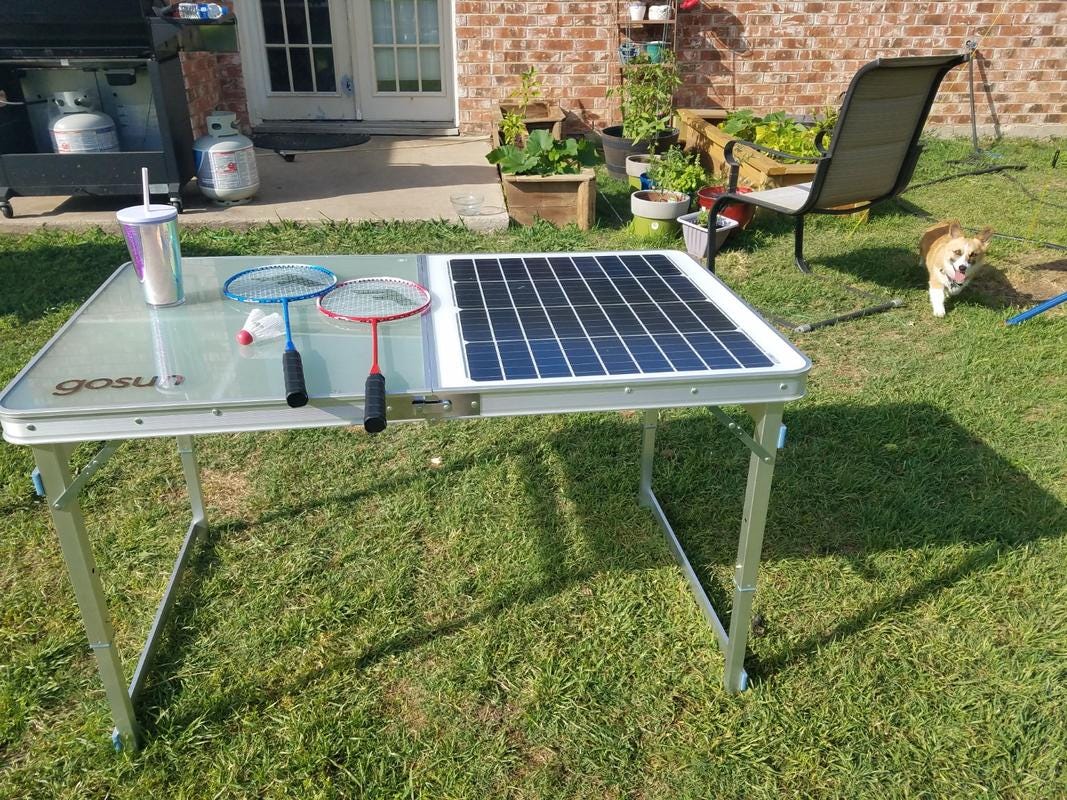Affordable Solar: The Energy Game Has Changed
Solar power is more affordable than coal, oil, gas, nuclear, hydro, and wind power.
Ten years ago, a 6,000-watt solar electricity system cost $50,000; today, you can buy it for less than $21,000—and get a 30% federal tax credit on top of that. Going solar is now a wise investment: the sooner you start using sunlight to meet your energy needs, the more money you’ll have. This action guide explores practical steps to harness sunshine for heat and electricity.
But first, an important announcement:
Since May, we have been sharing free action guides to help you become superbly sustainable. Starting in November, you can upgrade your subscription to enjoy exclusive privileges as a “sustainability champion” for just $5 a month (the price of a cup of coffee!).
We already have pledges from people who believe in our work. They don’t want to miss out on learning and connecting–and we know you won’t want to miss out, either.
Whether you stay on as a free subscriber or upgrade to a paid subscription, you will continue to get One Step This Week expert action guides every other week. But when you upgrade, you’ll get these additional benefits:
“My Steps To Sustainability”—a chance to participate in online discussions to share knowledge, develop good habits, and stay motivated to achieve your sustainability goals.
“Dispatches from New Zealand”— for the next six months, Fred Horch, our Principal Advisor, travels across the world and reports back on noteworthy sustainability practices. When those dispatches are via Zoom, you will receive a link a week in advance.
“Sustainable Insights”—Fred’s analysis of sustainability news and events for your family or your organization that you won’t find anywhere else and that can guide your actions.
A paid subscription makes the perfect sustainable holiday gift—an easy way to show respect and love for everyone on your list.
Thank you for joining us on the challenging but rewarding journey to sustainability!
On the energy pathway to sustainability, we’ve already explored efficiency and electrification, including an in-depth look at batteries to store and release electricity. Now let’s explore how to use solar power to meet our energy needs:
Allow sunlight to shine into our homes in winter, warming them up passively.
Install stand-alone solar modules for specific requirements like outdoor lighting or small battery charging.
Install solar modules connected to our home’s electrical wiring and panels.
Connect to a solar-powered microgrid in our neighborhood.
Instruct our local power utility to deliver electricity to us from a solar farm connected to our local power grid.
Buy solar renewable energy certificates.
Poll: Going Solar?
How to Heat Your Home for Free
Letting sunlight shine through your windows in winter heats your home for free. Well-designed “passive solar” homes get most of their heating for free; poorly-designed homes get almost no free solar heating. For an existing home, you can invite in more solar energy—and encourage it to stay longer—by taking these practical steps:
Use caulk or spray foam to seal up any small gaps in exterior walls that allow cold air to seep in.
Check and replace worn weatherstripping around doors and windows.
Remove screens and clean windows that get winter sun. In winter, screens and dirty windows just block sunlight that would otherwise help heat your home.
Trim back any bushes or trees blocking the winter sun from getting inside.
During the day, open blinds and shades on windows that get winter sun—you can close shades at night to help retain heat inside.
Use portable fans to blow air from rooms that get winter sun to other rooms that you want to be warmer.
Put up insulating inserts on windows that don’t get winter sun to keep heat from leaking out.
For a new home or significant renovations on an existing home, take bigger steps to let in winter sunshine and keep that free heat inside:
Air seal and insulate well to retain heat in winter.
Install windows with unobstructed views of the sun in winter to gain free heat.
Install mechanical ventilation to distribute warm air where you want it in your home.
Install landscaping and solar overhangs that block the sun in late spring, summer, and early fall to prevent overheating.

With modern passive solar building technology, including heat recovery ventilation, you can easily heat your entire home with heat pumps. A well-designed new home will require nothing more powerful than a heat pump to maintain a comfortable indoor temperature, even on the coldest winter day.
How to Charge Batteries for Free
Putting solar-powered devices in sunlight charges their batteries for free. But is this a sustainable step? Here are some questions to consider:
Am I buying more devices than I really need because solar-powered ones are so fun and convenient? This is especially true of items like outdoor lighting.
Can I replace the battery? Batteries will fail long before the solar panels, LED chips, and other electronic components do.
Does the device save money or resources compared to alternatives? For example, solar-powered outdoor flood lights don’t require running a power line to them, making them often much more affordable to install than wired lighting.
Solar is not only an option for powering small electronic devices like calculators, path lighting, and battery chargers but is also a choice for larger equipment like coolers. Solar “suitcases” (solar modules with kickstands) and solar tables make it easier and more convenient to collect solar energy in your yard, on your balcony, or at your campsite.
Attaching a few solar panels to a garage, shed, or greenhouse, then connecting those panels to charge a portable power station, is a sensible way to start making the transition to solar power. Use free solar energy to keep your portable power station charged up, then use your power station to recharge batteries for your electric power tools and equipment.
How to Power Your Home for Free
Enough free sunlight reaches the roof of most homes in North America to provide all the electricity they need. You can use satellite images from your favorite online maps (such as Google Maps or Bing Maps) to determine your home’s suitability for solar panels and use the PVWatts Calculator to estimate how much solar electricity you can make. If you can’t put enough modules on your roof, you can put them on a ground mount or on a solar carport, awning, or pavilion.
The catch, of course, is that it costs money to install the solar equipment that allows you to power your home for free. But if you’d like never to pay another power bill, here’s how to do it:
Upgrade to efficient lighting, heating, and other electrical equipment to lower the bar you must clear to produce all your own electricity.
Disconnect from the power grid; tell your local power utility that you are going “off grid.”
Install solar PV modules to charge batteries.
Install batteries so you have power all the time.
Install an inverter to convert direct current (DC) power from your batteries to alternating current (AC) for your household electrical needs.
Connect all these components, and connect the output of your inverter to your electrical panel.
For most people, free power isn’t worth the cost of batteries. It’s cheaper to go solar without batteries, but then you need to stay on the grid and keep paying for the privilege to remain connected.
How to Go Solar Without Going Off Grid
Staying on the power grid makes it cheaper to go solar. Here’s how:
Hire an electrician who can pull a permit and tell your local power utility that you are installing a “grid-connected” solar array on your property. Be aware that your local utility may tell you no, that they won’t allow you to connect your solar array to their grid.
Install solar PV modules.
Decide if you want to install batteries, too. You don’t need them in a grid-connected system, but they are good to have in case of power outages.
Install an inverter to convert direct current (DC) power from your solar modules (and batteries, if you have them) to alternating current (AC) for your household electrical needs.
Connect all these components, and connect the output of your inverter to your electrical panel.
Get your system inspected and comply with all the rules from your utility to allow your solar array to supply power to their grid.
Batteries are optional in a grid-connected system. Without batteries, when the grid goes down, your inverter will automatically shut off the flow of electricity. With batteries, when the grid goes down, your inverter might be able to create a “power island” to keep the lights on in your home using the energy from your solar array and your batteries.
How to Go Solar with Your Neighbors
You might have a sunny roof, and your neighbor might not, or vice versa. Or your neighborhood might have a big parking lot that could be generating power for many homes. Here’s how to share solar power among neighbors:
Change laws that prohibit microgrids from being built.
Decide how to share costs for building and maintaining a shared solar array.
Install solar PV modules in the best places in your neighborhood.
Install batteries.
Connect these batteries to everyone in your neighborhood who wants power.
Install inverters in the buildings that will be using solar power to convert DC from the batteries to AC for the loads.
This type of system is called a “DC microgrid” because power is distributed as direct current among a small number of people. Most jurisdictions in the United States prohibit DC microgrids so that utilities can enjoy a monopoly on selling electricity. But in the future, laws could change to make it easier for entire neighborhoods to go solar together, sharing the power and the costs.
How to Go Solar Over the Grid or Beyond
Most of us can’t directly connect to a “solar garden” (a small shared array) in our neighborhood, but we might be able to choose our electricity supplier as a virtual way to connect to a “solar farm” (a large shared array). If our local utility allows it, we can choose to buy electricity from any solar farm connected to the power grid we’re using. Failing that, we can buy solar renewable energy certificates to reward and encourage people who are building solar arrays and sending solar electricity to a power grid.
Which Pathway We’ll Explore Next
Earlier this year, we explored the pathway to sustainable movement and then the related pathway to sustainable energy. Next, in time for the holiday gift-giving season, we’ll start on the pathway to sustainable goods. Stay with us on the journey to sustainability as we take action to have a positive impact on the world.
References and Further Reading
How much do solar panels cost in 2023?, EnergySage
Homeowner’s Guide to the Federal Tax Credit for Solar Photovoltaics, Solar Energy Technologies Office, Office of Energy Efficiency & Renewable Energy, United States Department of Energy
PVWatts Calculator, National Renewable Energy Laboratory
Microutility Plan Down but not Out in California, Microgrid Knowledge
State Solar Renewable Energy Certificate Markets, United States Environmental Protection Agency






